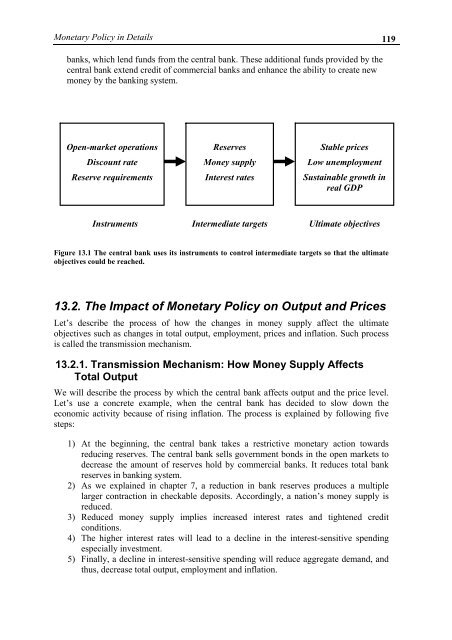MacroeconomicsI_working_version (1)
Create successful ePaper yourself
Turn your PDF publications into a flip-book with our unique Google optimized e-Paper software.
Monetary Policy in Details 119<br />
banks, which lend funds from the central bank. These additional funds provided by the<br />
central bank extend credit of commercial banks and enhance the ability to create new<br />
money by the banking system.<br />
Open-market operations<br />
Discount rate<br />
Reserve requirements<br />
Reserves<br />
Money supply<br />
Interest rates<br />
Stable prices<br />
Low unemployment<br />
Sustainable growth in<br />
real GDP<br />
Instruments Intermediate targets Ultimate objectives<br />
Figure 13.1 The central bank uses its instruments to control intermediate targets so that the ultimate<br />
objectives could be reached.<br />
13.2. The Impact of Monetary Policy on Output and Prices<br />
Let’s describe the process of how the changes in money supply affect the ultimate<br />
objectives such as changes in total output, employment, prices and inflation. Such process<br />
is called the transmission mechanism.<br />
13.2.1. Transmission Mechanism: How Money Supply Affects<br />
Total Output<br />
We will describe the process by which the central bank affects output and the price level.<br />
Let’s use a concrete example, when the central bank has decided to slow down the<br />
economic activity because of rising inflation. The process is explained by following five<br />
steps:<br />
1) At the beginning, the central bank takes a restrictive monetary action towards<br />
reducing reserves. The central bank sells government bonds in the open markets to<br />
decrease the amount of reserves hold by commercial banks. It reduces total bank<br />
reserves in banking system.<br />
2) As we explained in chapter 7, a reduction in bank reserves produces a multiple<br />
larger contraction in checkable deposits. Accordingly, a nation’s money supply is<br />
reduced.<br />
3) Reduced money supply implies increased interest rates and tightened credit<br />
conditions.<br />
4) The higher interest rates will lead to a decline in the interest-sensitive spending<br />
especially investment.<br />
5) Finally, a decline in interest-sensitive spending will reduce aggregate demand, and<br />
thus, decrease total output, employment and inflation.




